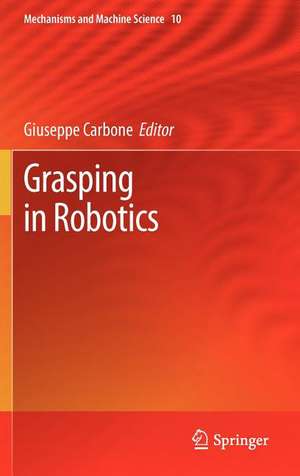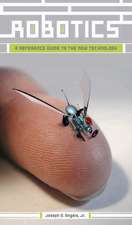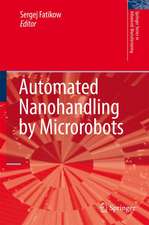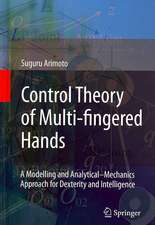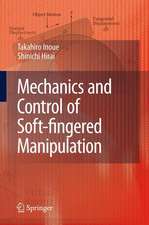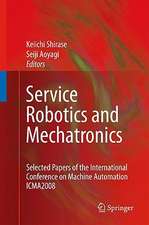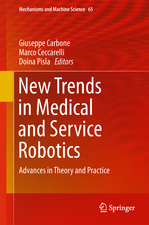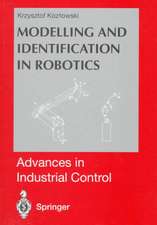Grasping in Robotics: Mechanisms and Machine Science, cartea 10
Editat de Giuseppe Carboneen Limba Engleză Hardback – 15 noi 2012
The contributors to this book are experts in their own diverse and wide ranging fields. This multidisciplinary approach can help make Grasping in Robotics of interest to a very wide audience. In particular, it can be a useful reference book for researchers, students and users in the wide field of grasping in robotics from many different disciplines including mechanical design, hardware design, control design, user interfaces, modelling, simulation, sensors and humanoid robotics. It could even be adopted as a reference textbook in specific PhD courses.
| Toate formatele și edițiile | Preț | Express |
|---|---|---|
| Paperback (1) | 953.03 lei 6-8 săpt. | |
| SPRINGER LONDON – 14 dec 2014 | 953.03 lei 6-8 săpt. | |
| Hardback (1) | 959.19 lei 6-8 săpt. | |
| SPRINGER LONDON – 15 noi 2012 | 959.19 lei 6-8 săpt. |
Din seria Mechanisms and Machine Science
- 20%
 Preț: 817.44 lei
Preț: 817.44 lei - 17%
 Preț: 364.75 lei
Preț: 364.75 lei - 20%
 Preț: 1001.90 lei
Preț: 1001.90 lei - 18%
 Preț: 1268.55 lei
Preț: 1268.55 lei - 18%
 Preț: 945.79 lei
Preț: 945.79 lei - 18%
 Preț: 1275.65 lei
Preț: 1275.65 lei - 18%
 Preț: 1392.46 lei
Preț: 1392.46 lei - 18%
 Preț: 1386.17 lei
Preț: 1386.17 lei - 18%
 Preț: 2142.21 lei
Preț: 2142.21 lei - 18%
 Preț: 1382.21 lei
Preț: 1382.21 lei - 15%
 Preț: 604.87 lei
Preț: 604.87 lei - 18%
 Preț: 1104.43 lei
Preț: 1104.43 lei - 18%
 Preț: 2768.05 lei
Preț: 2768.05 lei - 18%
 Preț: 1625.27 lei
Preț: 1625.27 lei - 18%
 Preț: 1872.30 lei
Preț: 1872.30 lei - 18%
 Preț: 899.21 lei
Preț: 899.21 lei - 18%
 Preț: 1550.30 lei
Preț: 1550.30 lei - 18%
 Preț: 1832.85 lei
Preț: 1832.85 lei - 18%
 Preț: 1572.40 lei
Preț: 1572.40 lei - 18%
 Preț: 1549.54 lei
Preț: 1549.54 lei - 15%
 Preț: 649.87 lei
Preț: 649.87 lei - 18%
 Preț: 950.52 lei
Preț: 950.52 lei - 18%
 Preț: 953.97 lei
Preț: 953.97 lei - 18%
 Preț: 1217.10 lei
Preț: 1217.10 lei - 18%
 Preț: 1387.73 lei
Preț: 1387.73 lei - 18%
 Preț: 1218.21 lei
Preț: 1218.21 lei - 18%
 Preț: 1546.05 lei
Preț: 1546.05 lei - 18%
 Preț: 1550.30 lei
Preț: 1550.30 lei - 18%
 Preț: 1846.73 lei
Preț: 1846.73 lei - 18%
 Preț: 1538.34 lei
Preț: 1538.34 lei - 18%
 Preț: 1000.24 lei
Preț: 1000.24 lei - 18%
 Preț: 1397.82 lei
Preț: 1397.82 lei -
 Preț: 448.88 lei
Preț: 448.88 lei - 18%
 Preț: 1233.52 lei
Preț: 1233.52 lei
Preț: 959.19 lei
Preț vechi: 1169.74 lei
-18% Nou
Puncte Express: 1439
Preț estimativ în valută:
183.56€ • 199.32$ • 154.19£
183.56€ • 199.32$ • 154.19£
Carte tipărită la comandă
Livrare economică 22 aprilie-06 mai
Preluare comenzi: 021 569.72.76
Specificații
ISBN-13: 9781447146636
ISBN-10: 1447146638
Pagini: 476
Ilustrații: VIII, 468 p.
Dimensiuni: 155 x 235 x 31 mm
Greutate: 0.84 kg
Ediția:2013
Editura: SPRINGER LONDON
Colecția Springer
Seria Mechanisms and Machine Science
Locul publicării:London, United Kingdom
ISBN-10: 1447146638
Pagini: 476
Ilustrații: VIII, 468 p.
Dimensiuni: 155 x 235 x 31 mm
Greutate: 0.84 kg
Ediția:2013
Editura: SPRINGER LONDON
Colecția Springer
Seria Mechanisms and Machine Science
Locul publicării:London, United Kingdom
Public țintă
ResearchCuprins
Historical Background of Grasping.- A Survey on Different Control Techniques for Grasping.- Path Planning for Grasping Tasks.- Wrists for Enhancing Grasping Performance.- Industrial Grippers: State-of-Art and Main Design Characteristics.- Microgrippers: State-of-Art and Main Design Solutions.- A New Way of Grasping: ParaGrip – Robot and Gripper Rolled Into One.- Robotic Hands: State-of-Art and Low-Cost Design Solutions.- Hardware Control for Robotic Hands.- Finger Orientation for Robotic Hands.- Using Vision in Grasping Tasks.- Integrated Grasp and Motion Planning for Humanoid Robots.- Grasping in Agriculture.- A Multibody Dynamics Formulation.
Notă biografică
Giuseppe Carbone was born in Salerno in 1972. He got a degree cum laude as a mechanical engineer and a PhD degree in mechanical and civil engineering at the University of Cassino in 2000 and 2004, respectively. He is currently Assistant Professor at Laboratory of Robotics and Mechatronics (LARM) in Cassino. He is also Associate Editor of the international journal Robotica. He is Associate Editor for ICRA 2011 and IROS 2011. He is Senior Member of IEEE. He was a visiting scholar at the Humanoid Robotics Institute, Waseda University, Tokyo, Japan, for about one year spread over several periods during the years between 2002 and 2005, also supported by an Italian National Research Council CNR grant. His research interests cover aspects of mechanics of robots, mechanics of manipulation and grasp and mechanics of machinery. He is the author and/or co-author of about 170 papers that have been published in proceedings of national and international conferences or in international journals.
Textul de pe ultima copertă
Grasping in Robotics contains original contributions in the field of grasping in robotics
with a broad multidisciplinary approach. This gives the possibility of addressing all the
major issues related to robotized grasping, including milestones in grasping through
the centuries, mechanical design issues, control issues, modelling achievements and
issues, formulations and software for simulation purposes, sensors and vision integration,
applications in industrial field and non-conventional applications (including service
robotics and agriculture).
The contributors to this book are experts in their own diverse and wide ranging fields.
This multidisciplinary approach can help make Grasping in Robotics of interest to a very
wide audience. In particular, it can be a useful reference book for researchers, students
and users in the wide field of grasping in robotics from many different disciplines
including mechanical design, hardware design, control design, user interfaces, modelling,
simulation, sensors and humanoid robotics. It could even be adopted as a reference
textbook in specific PhD courses.
with a broad multidisciplinary approach. This gives the possibility of addressing all the
major issues related to robotized grasping, including milestones in grasping through
the centuries, mechanical design issues, control issues, modelling achievements and
issues, formulations and software for simulation purposes, sensors and vision integration,
applications in industrial field and non-conventional applications (including service
robotics and agriculture).
The contributors to this book are experts in their own diverse and wide ranging fields.
This multidisciplinary approach can help make Grasping in Robotics of interest to a very
wide audience. In particular, it can be a useful reference book for researchers, students
and users in the wide field of grasping in robotics from many different disciplines
including mechanical design, hardware design, control design, user interfaces, modelling,
simulation, sensors and humanoid robotics. It could even be adopted as a reference
textbook in specific PhD courses.
Caracteristici
Gives an historical background to grasping in robotics with the first achievements in this field and its evolution through the centuries Addresses mechanical design issues for both grippers and robotic hands Includes various applications, such as humanoid robots and horticulture harvesting Includes supplementary material: sn.pub/extras
